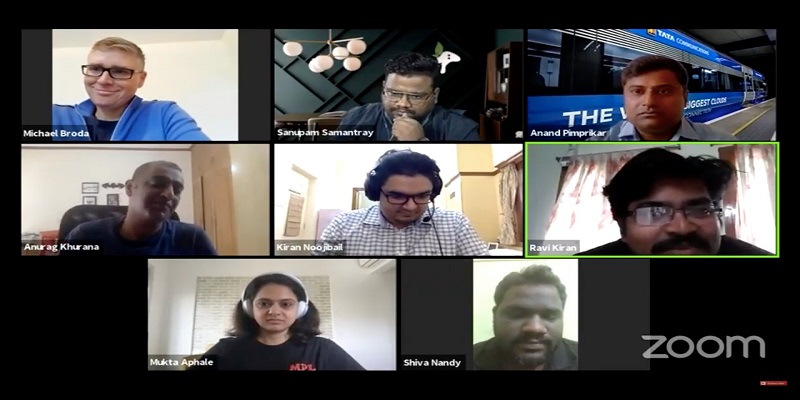
As the current pandemic mandated stay-at-home measures, the gaming and esports industry started booming in terms of new users, DAU rate engagement, and so on. The esports organizations and streaming platforms had to work fortnightly to engage the large rising number of users and players, that too remotely. And these large number of gaming content consumers are not just consuming content in English, but are also consuming it in regional languages as the consumers reach has expanded to tier 2, tier 3, and beyond cities.
To cater to everyone in a nationwide lockdown, it was crucial for the organizations to put everything in a fully remote operation with low latency rate featuring a virtual production control room accessible to multiple producers, technical directors, sound engineers and other staff.
AnimationXpress and Indiantelevision organised GEMS 2020 Summit and in today’s session on “Esports Production: Going Remote”, we had Gaming and Esports veteran Anurag Khurana, Tata Communications head sales, BD – India, Media and Entertainment Services Anand Pimprikar, SKY ESPORTS founder and CEO Shiva Nandy, Esports and broadcasting LXG director Kiran Noojibail, MPL VP – devops and reliability engineering Mukta Aphale, Playtonia Esports co-founder Sanupam Samantray, ESPL chief executive officer Michael Broda as speakers and the moderator was ICBC Core Member GoLIVE Games Studios Ravi Kiran. The discussion revolved around the esports scene in India.
During the pandemic, the esports live streams from gamers in different locations are ingested simultaneously through a cloud-based infrastructure and made available for distribution to multiple broadcast endpoints in real-time. That includes both for viewing on audience platforms such as Twitch, YouTube and Facebook, or on TV or for viewing by production staff and talent while producing a show to be aired on a particular date.
Esports is a huge industry today, Noojibail expressed that today esports is primarily online therefore the focus is on the broadcast of the match, glimpses, players, and the content around it. Over the last six months where everything went online and there were many LAN events therefore the challenge has been around to achieve the same quality of content while working remotely. And today all the esports organizations are aiming to produce quality remotely.
Thus Aphale says, “Esports is the star of sports entertainment of the world today and it is gaining a lot of traction and people are enjoying that.” India has a huge pipeline of talent and to scale up that talent through content, technology support should be on par to produce quality content.
Adding to that Broda expressed that they are targeting casual gamers who want to start becoming competitive. They are optimistic about the esports industry which is growing 20-25 per cent every year. Adding to that “micro-influencers are a hot topic today” and right now esport players (at lower levels and not pro) are aiming to influence the fanbase to consume more engaging esports content. In order for esports to become successful and to come under notice, it needs to be a multiplayer game. Lastly, Broda added that, “We see esports as a global industry and not a local industry.”
“In esports, a gamer requires 3 things: content, name, and fame. During the lockdown, it became a bit slow initially but in the last few weeks, the content started skyrocketing thus it has expanded the use of devices as it’s coming on tablets, mobiles and so on. Today there are a large number of mobile platforms that have come up with esports and game streaming,” Samantray said. He opined that because of device preferences, a lot of new users are entering, and due to multiplayer feature and other features, esports is equally popular as any other sports. Therefore, there has to be a federation which should recognize and help the sector to boom.
Pimprikar said, “The question isn’t about whether there is a favorable infrastructure for esports or not. It’s about finding the mass following galvanizing the industry like Pubg. A company has to look for various aspects of production that include: how do you separate the production control on-site and the output.”
Since esports is becoming big like any other sports, Nandy added that in no time, ‘IPL of esports will be the next big thing.’ Skyesports showdown tournament which was streamed in various platforms in regional languages like Tamil and Malayalam has also witnessed a lot of traction and engaged users. Thus today esports enthusiasts are not just limited to regions, it is growing all around. “We need to build grassroot players and bring the general audience to watch esports. This needs to evolve as that’s how cricket became the number one game,” Nandy added.
Esports content is different from streamers streaming a game. Khurrana concluded, “We need esports to be an all-inclusive content. We have to take esports with a focus that is not just limited to tier 1 cities but also tier 2, tier 3, and beyond. Once esports comes to the mainstream industry, things will change. Next superstars are going to be from esports (probably in the coming two to three years). Esports is still evolving in India. For us to compete at a better level internationally, we will need psychologists, physiotherapists, sports coaches, and more.”

